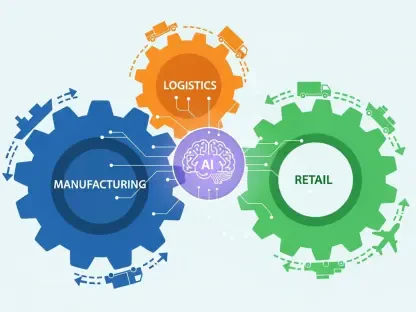In an era where Artificial Intelligence (AI) is reshaping industries and driving innovation, the integration of these technologies into critical systems brings both unprecedented opportunities and significant risks. From healthcare diagnostics to financial forecasting, AI handles sensitive data and makes decisions impacting millions, yet the potential for breaches—such as data tampering or model theft—poses a severe threat to trust and operational stability. The rise in sophisticated attacks tailored to exploit AI-specific vulnerabilities underscores a pressing need for robust security measures. AI security frameworks emerge as vital tools in this landscape, offering structured strategies to shield systems from emerging dangers. These frameworks not only address prevention but also ensure readiness for response, creating a comprehensive defense mechanism for organizations navigating the complexities of AI deployment. This exploration delves into how such frameworks fortify systems, mitigate risks, and foster confidence in AI technologies amidst a rapidly evolving threat environment.
As AI continues to permeate critical sectors, the limitations of traditional cybersecurity approaches become increasingly apparent. Standard defenses often fail to counter threats like prompt injection or inference attacks, which are uniquely tied to AI architectures. Industry collaboration has become a cornerstone in addressing these gaps, with technology leaders and experts uniting to develop standardized practices. These efforts aim to embed security into every phase of the AI lifecycle, ensuring that vulnerabilities are tackled proactively. By examining the core components and benefits of AI security frameworks, a clearer picture emerges of how they serve as indispensable allies in protecting systems while enabling organizations to harness AI’s full potential without fear of compromise.
Understanding the Need for AI Security Frameworks
Addressing Unique Vulnerabilities in AI Systems
AI technologies, while transformative, introduce a spectrum of vulnerabilities that differ markedly from traditional IT systems, such as data poisoning where malicious inputs corrupt training datasets, or model theft that compromises intellectual property. These risks can lead to flawed decision-making or significant breaches, impacting everything from business operations to public safety. Unlike conventional cybersecurity threats, AI-specific dangers often exploit the very mechanisms that make these systems powerful, such as their ability to learn and adapt. The absence of tailored defenses leaves organizations exposed, as legacy tools struggle to detect or mitigate these nuanced attacks. Specialized AI security frameworks fill this critical void by providing structured methodologies to identify, prevent, and respond to such threats, ensuring that systems remain reliable even as adversaries refine their tactics.
Beyond the technical challenges, the stakes of AI security extend to trust and reputation, as a single breach can erode confidence among stakeholders and customers alike. The rapid pace of AI adoption across industries amplifies the urgency to address these vulnerabilities before they are exploited on a larger scale. Frameworks designed for AI security emphasize a proactive stance, embedding safeguards into development processes to stop issues before they arise. They also facilitate compliance with emerging regulations that demand accountability in AI usage. By aligning security practices with the unique nature of AI systems, these frameworks offer a pathway to mitigate risks while supporting innovation, ensuring that the benefits of AI are not overshadowed by preventable failures.
Evolving Threats in the AI Landscape
The threat landscape for AI systems is evolving at an alarming rate, with attackers continuously devising new methods to exploit weaknesses, such as inference attacks that manipulate model outputs by analyzing responses. These sophisticated strategies often bypass traditional security perimeters, targeting the core functionalities of AI models. As AI becomes integral to mission-critical applications, the potential consequences of such exploits grow, ranging from financial losses to compromised safety in autonomous systems. The dynamic nature of these threats means that static defenses quickly become obsolete, necessitating adaptive and forward-thinking solutions. AI security frameworks are crafted to anticipate these shifts, incorporating mechanisms to monitor and counter emerging risks before they cause widespread harm.
Moreover, the complexity of AI architectures, particularly in agentic systems capable of autonomous decision-making, adds another layer of difficulty in securing them against novel attacks. Frameworks tailored to this environment provide not just reactive measures but also predictive insights, helping organizations stay one step ahead of potential breaches. They draw on collaborative industry knowledge to ensure that guidelines remain relevant amid rapid technological advancements. By focusing on continuous improvement and adaptability, these frameworks help fortify AI systems against a backdrop of ever-changing threats, offering a robust defense that evolves in tandem with the technologies they protect.
Key Components of AI Security Frameworks
Safeguarding Model Integrity with Signing Practices
A fundamental pillar of AI security lies in ensuring the integrity of machine learning models before they are deployed in high-stakes environments, where even minor tampering can lead to catastrophic outcomes. Model signing, a key component of many security frameworks, employs digital signatures to create tamper-proof records, verifying that models remain unaltered from their original state. This process often follows a staged maturity model, starting with basic integrity checks and advancing to signature chaining for traceability across the supply chain. Structured governance policies further enhance control, ensuring interoperability across diverse AI ecosystems. By embedding such mechanisms, organizations can significantly reduce the risk of unauthorized modifications, fostering trust among stakeholders who rely on the accuracy and reliability of these models.
Equally important is the role of model signing in maintaining visibility throughout the AI lifecycle, from development to deployment in real-world applications. This transparency allows for continuous monitoring and validation, ensuring that any discrepancies are flagged before they escalate into major issues. The business value of this approach cannot be overstated, as it not only mitigates security risks but also streamlines compliance with regulatory standards that demand proof of authenticity. Frameworks that prioritize model signing provide a practical roadmap for implementation, accommodating organizations at varying levels of readiness. This flexibility ensures that even those just beginning to integrate AI can adopt these practices, building a foundation of trust that supports long-term innovation and operational stability.
Tailored Incident Response for AI-Specific Attacks
When AI systems face threats like model theft or prompt injection, the inadequacy of traditional incident response plans becomes glaringly evident, as these attacks exploit unique aspects of AI functionality. Security frameworks designed for AI incident response offer comprehensive strategies to detect, contain, and remediate such threats, bridging gaps left by conventional cybersecurity protocols. These frameworks provide detailed playbooks and real-world examples tailored to common AI use cases, enabling organizations to transition from theoretical preparedness to actionable outcomes. By addressing the nuances of AI-specific risks, they ensure that incidents are managed with precision, minimizing disruption and preserving system integrity even under sophisticated attacks.
Additionally, these incident response frameworks tackle the challenges posed by advanced AI architectures, such as agentic systems that make autonomous decisions, by offering forensic investigation guidelines and prioritized security steps. They emphasize auditability and resilience, ensuring that recovery processes are swift and transparent, which is crucial for maintaining stakeholder confidence post-incident. The focus on scalability allows organizations to adapt mitigation strategies as their AI deployments grow, while layered defense recommendations provide depth against multifaceted threats. By integrating these tailored responses, frameworks empower defenders to navigate the complexities of AI security, ensuring that systems remain robust in the face of inevitable challenges and evolving adversarial tactics.
Benefits of Implementing AI Security Frameworks
Strengthening Trust and Regulatory Alignment
The adoption of AI security frameworks plays a pivotal role in cultivating trust among stakeholders by ensuring that AI systems are both secure and accountable, a necessity in sectors where reliability is non-negotiable. These frameworks enable organizations to maintain clear visibility and control over their AI assets, from model creation through to deployment, reassuring clients and partners of their commitment to safeguarding sensitive data. Alignment with industry standards embedded in these frameworks also simplifies compliance with an increasingly stringent regulatory landscape, mitigating the risk of legal or financial penalties. As AI continues to underpin critical operations, demonstrating adherence to best practices through framework implementation becomes a powerful signal of responsibility, enhancing reputation and fostering confidence in technology-driven solutions.
Furthermore, the structured nature of these frameworks provides a consistent approach to meeting diverse regulatory demands across jurisdictions, which is vital for global enterprises operating in varied compliance environments. They offer actionable steps to document and validate security measures, ensuring that audits and assessments are streamlined and effective. This not only reduces the burden of regulatory oversight but also positions organizations as leaders in ethical AI deployment, a growing priority for governments and industry bodies alike. By prioritizing trust and compliance, AI security frameworks help businesses navigate the delicate balance between innovation and accountability, ensuring that the transformative power of AI is harnessed without compromising on essential safeguards.
Bolstering Resilience Amid Dynamic Risks
In a landscape where AI threats evolve with alarming speed, security frameworks provide a dual approach of prevention and response that significantly enhances organizational resilience against current and future risks. By embedding security into every stage of the AI lifecycle, from design to operation, these frameworks ensure that vulnerabilities are addressed before they can be exploited, reducing the likelihood of breaches. Simultaneously, they equip teams with robust incident management strategies to handle attacks when they occur, ensuring minimal impact on operations. This comprehensive preparedness allows businesses to leverage AI for competitive advantage while maintaining a strong defense against sophisticated threats that could undermine their stability.
Moreover, the adaptability of AI security frameworks ensures they remain relevant as new challenges emerge, incorporating insights from industry collaboration to refine and update defensive tactics. They support the development of layered security measures that protect against multifaceted attacks, while also providing scalability to accommodate growing AI implementations. This resilience is critical for organizations aiming to stay ahead in a technology-driven world, where the ability to anticipate and respond to risks can define success. By embracing these frameworks, entities can confidently pursue AI innovation, knowing that their systems are fortified against the dynamic and unpredictable nature of modern cyber threats.









